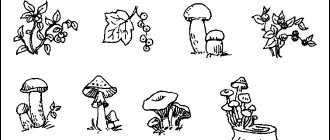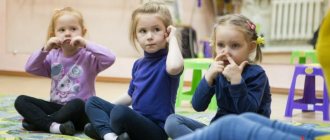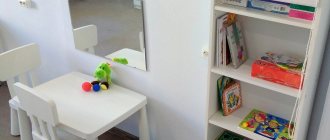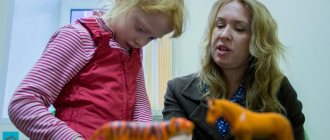No child comes into the world talking. The ability to learn speech is a natural human property, inherent from birth. The native language of the “little man” becomes the one spoken by those closest to him. Significant adults for the child are parents or legal representatives.
Senior preschool age is a period of formation of new mental qualities and improvement of processes of cognitive activity. “Perestroika” is taking place: children comprehend information about themselves and analyze the world around them. New opportunities also open up for the baby’s speech.
The period of changes has not spared the preschool education system. The Federal State Educational Standard has made its contribution. The changes affected educational activities and the level of professionalism of teachers and educators. The Federal State Educational Standard identifies 5 educational areas, speech development is one of them.
Speech development of children in older preschool age
Speech development is a designation of stages and techniques in a complex associated with mastering the means of speech, which are characterized by the development of verbal thinking, communication and creativity skills.
Speech is a dynamic phenomenon. Language does not stand still, but adapts to conditions and realities. Children feel these innovations better than us. The preschool stage is determined by intensive speech development. The children are making a leap in expanding their vocabulary. The speech became concrete and meaningful. At older preschool age, a child’s vocabulary already reaches 3-4 thousand words. During this period, children develop a “sense of language.” The young “linguist” intuitively senses the language norm. The child provides comments on the actions. Says: what am I doing now?
The growing needs of a preschooler act as a motive for language acquisition. The speech regulation function develops, which helps control activity and behavior. All activities are related to speech. The preschooler has new tasks and his social circle among peers and adults expands. It is important for a child to be understood by his interlocutors. The “little man” listens to people’s speech and copies the phrases and phrases he likes.
Observations play a role in vocabulary acquisition. The ability to see and feel the beauty of nature is formed during walks in the fresh air. Let them want to talk about the color of the clouds or the shape of the leaves on the trees! In the process of observation, children's vocabulary expands, and sentences acquire complex structures. .
Features of speech development of older preschoolers
A child of 5-7 years old monitors the pronunciation features of his peers and some errors in his own speech, and masters the sound analysis of words. It is not immediately possible without errors: sibilants are not pronounced clearly, in complex words syllables are rearranged, the letter “P” is not pronounced. A kindergartener's number of simple, common and complex sentences increases. Errors occur when changing words by case, especially when forming nouns in the genitive plural (“no gloves”). Teachers guide children in the correct use of grammatical forms. To understand how nouns are formed, let’s introduce children to the concept of a word-formation pair; Let's tell you how, with the help of the same suffix, words are formed that indicate a person (work-worker, gardener-gardener) or an object (rain-raincoat).
At this age, the child retells fairy tales or short stories, and comes up with a plot based on a series of paintings. Children are able to identify a topic and arrange parts of a text sequentially. With the help of adults, he selects words with the same root. The children form and use comparative adjectives in speech (strong - stronger; bright - brighter). They correctly understand and use prepositions without errors. Having heard an unfamiliar word, preschoolers often change it into one that is known. Mistakes occur, this is due to the identity of the roots: robber-rake.
Some children do not know how to use intonation or monitor the speed and volume of speech. In the senior group of kindergarten, a new type of work is introduced: children are introduced to the verbal composition of a sentence. Working on the intonation and expressiveness of speech will also help: we teach children to express their attitude to what is happening with their voice (raising and lowering their voices, placing logical stresses).
Gymnastics for waking up after sleep for the 2nd junior group of preschool educational institutions
Dialogical speech is important for a child: he lives in society. Teachers are working to improve it. Here we include:
- Ability to listen and understand the interlocutor;
- Formulate questions;
- Build a replica based on the task at hand;
- Use the norms of speech etiquette (greetings, farewells).
Instill in children the ability to build a dialogue: ask, support, thank, answer, ask for forgiveness.
To do this, conversations are held on various topics that are related to life in the family and in kindergarten. The baby learns to listen to the interlocutor and ask questions. The skills that a child acquires during the construction of dialogic speech will also be useful in monologue. Parents often devote themselves to everyday work without reserve, so they do not pay due attention to the child’s speech development. The preschooler has a poor vocabulary.
Close cooperation between family and kindergarten is the path to correct speech and a rich vocabulary. It is important that you talk to your child at home: read books aloud, discuss the events of the day.
Diagnosis of speech development in children of senior preschool age
In the preschool period, shortcomings in the child’s speech development become obvious. Delay in speech development negatively affects the baby’s behavior and activities. Disturbances in the child’s speech development are identified during diagnostic testing. Corrective work begins with diagnosis.
When examining a child, they analyze: the development of sound analysis, phonemic hearing, the composition and richness of the vocabulary, communication skills, and the grammatical structure of speech.
Diagnosis of children is carried out on the basis of diagnostic methods for examining different aspects of the speech of preschool children, recommended by O.S. Ushakova, E.A. Strebeleva, E.M. Strunina. Based on the diagnostic results, the levels of children's speech development are revealed: high, average, below average, low. Levels of formation reflect a set of universal educational actions that a kindergartener acquires after mastering the educational program. Diagnosis is carried out according to several criteria.
- Vocabulary : richness of vocabulary; the ability to select words that denote the qualities of an object; understanding the characteristics and qualities of an object.
- Sound culture of speech : auditory attention; the ability to distinguish vowels and consonants; the ability to characterize sounds in a word; the ability to combine sounds into groups.
- Grammatical structure of speech : the ability to describe an object (a picture from a book or a toy); the ability to create a description without visualization, based on life experience; ability to write a story based on pictures; ability to retell according to a pattern.
Techniques for the development of coherent speech : speech patterns, questions, explanations, motivated assessment of children’s answers and actions, skit games.
The literature describes methods for studying the coherent speech of preschoolers. Children are given tasks at the reproductive and productive levels. In the first case, the preschooler is given a template to retell or repeat. In the second, we use a toy or a picture from a magazine. The child creates an independent statement. When teaching, it is permissible to use 2-4 toys: in stories about games and play actions, the coherence of children's statements increases. At the beginning of teaching storytelling, ready-made game situations are used, which are played out by an adult.
Speech development indicators | |
| Mastery of a dictionary | Activation of adjectives and verbs. The ability to select words that are accurate in meaning in a speech situation |
| The ability to select antonyms and synonyms for given words of different parts of speech | |
| Ability to understand and use different meanings of polysemantic words | |
| Ability to differentiate general concepts (wild and domestic animals, etc.) | |
| Grammar | Ability to form names of baby animals |
| Ability to select cognate words | |
| Ability to agree nouns and adjectives in gender and number | |
| Ability to form difficult forms of the genitive case (hares, foals, lambs) | |
| Ability to form difficult forms of the imperative and subjunctive mood (hide, dance, look) | |
| Ability to construct complex sentences of various types | |
| Phonetics | Ability to differentiate pairs of sounds s-z, s-ts, sh-zh, l-r |
| Ability to distinguish between hissing, whistling and sonorant sounds | |
| Ability to distinguish between hard and soft sounds | |
| The ability to change the strength of the voice, tempo of speech, voice strength, intonation depending on the content of the statement | |
| Ability to select words and phrases that sound similar | |
| Connected speech | In retelling literary works, the ability to convey the dialogue of the characters and the characteristics of the characters |
| Ability to write descriptions, narrations and reasoning | |
| The ability to develop a storyline in a series of paintings, connecting parts of a statement using different types of connections | |
| General indicators of children's speech development | |
Norms of speech development in a preschooler from 3 to 7 years old
The results of studies of the speech of preschoolers make it possible to establish average indicators. Let's consider what levels of speech development are expected at each age stage - for younger, middle and older preschoolers. For convenience, we present the data in a table.
Table. Approximate norms for speech development of preschool children
| Age | Lexicon | Level of speech development |
| 3-4 years | up to 1900 words | Speech is situational, using indefinite forms there, like that. Makes simple sentences. Uses verbs, nouns and pronouns (often demonstrative this, that). Pronunciation: softens the sound, does not pronounce the sound R, less often – L, K, G. replaces hissing sounds with whistling ones. |
| 4-5.5 years | 2000-2500 words | Expands the use of adjectives. Literally understands the meaning of the word. He is interested in the sound of words, composes rhymes and new consonant words. Uses diminutive suffixes. Uses conjunctions a, and, but, as well as subordinates that, when, because... Expresses quantitative and qualitative relationships: many-few, high-low... Pronunciation: overcomes softening, masters almost all sounds, partially copes with the pronunciation of R. |
| 5.5-7 years | up to 4000 words | Speech is coherent and detailed. Composes messages from several sentences united by a common meaning. Builds sentences correctly from a grammatical point of view. Modifies words using suffixes. Masters the declension of nouns and the conjugation of verbs. Sound pronunciation must be correct. |
Children of senior preschool age and speech creativity
The imagination of preschoolers differs from the imagination of adults. At this age, imagination is comparable to intellectual activity, which is aimed at changing the world around us. The baby “rises” above the situation and sees what is happening through the eyes of objects, fairy-tale characters and even phenomena.
Teaching creative storytelling is a difficult stage of work that forms a child’s coherent speech. Children learn to come up with a plot, course of events and denouement, describe the place and time of action, observe logical connections in the development of the plot, distinguish reality from fiction. Preschoolers imagine the characters' outfits, describe their character, facial features, and hairstyle. Provide your child with a field for creativity - endowing objects with magical powers, composing fairy tales, fantasizing, adapting a fictional character to life. The main characters of fairy tales are favorite toys and cartoon characters. A child easily compares himself with a fairy-tale character: girls dream of a dress like a princess, and boys dream of a cloak that gives magical powers.
When creating a fairy tale, the child independently makes a selection of events, drawing material from personal and literary experience. He also creates his own images of heroes, events, and draws a plot. With children of senior preschool age, they play out stories of a fairy-tale nature: “The Story of an Old Chest,” “The Adventures of Santa Claus in the Forest,” “My Favorite Cartoon.” The development of thinking has a positive effect on the development of the semantic side of a preschooler’s speech activity.
Such tasks develop imagination, improve vocabulary, and enrich the structure of speech. Science has proven that children’s understanding of the world is formed earlier than coherent speech. Often, during a retelling, the child strives to say more: as a result, he becomes silent, remembers, and selects words. Help your child translate words from passive to active vocabulary. To do this we use:
- Logic problems;
- Games for mastering gender categories;
- Games for the formation of figurative speech;
- Games for the development of personal business qualities;
- Games for the ability to find fables and true events in the text.
It is worth mentioning the acquaintance with children's literature and book culture. They don't read in the family, i.e. Children have no experience of family reading and active listening; the book is not valuable. The development of the child is carried out in a complete developmental environment. The natural environment is filled with sensory tools and play materials. In a group room, you can’t do without an audio and video library. Classes are held in a friendly environment.
Take into account one more methodological point - the speech activity of the teacher. At the same time, the teacher does not interfere with the child’s creativity, understands and accepts the child’s position. A preschooler teaches himself independently, relying on creativity and personal experience. Even a shy baby opens up.
At preschool age, children's speech is formed. During this period, speech requires attention from adults. Under its influence, views, consciousness, sense of will and character are formed. Cognitive processes are also improved with the help of speech. By the beginning of the first academic year at school, children have mastered the word-formation model of their native language, and the traditional norms of pronunciation of words are fixed in their heads.
In January 2021, the International Scientific and Practical Conference “Language and Current Problems of Education”
, dedicated to the issues of teaching Russian as a native language and the development of speech culture at each of the educational stages - in kindergarten, at school and in universities.
The conference was organized and held with the participation of the Institute for the Study of Childhood, Family and Education of the Russian Academy of Education, the International Academy of Sciences of Pedagogical Education, Moscow State Regional University, State Institute of Russian Language named after. A. S. Pushkin, Moscow Pedagogical State University. Based on materials from the participants of this event, a collection of scientific articles was compiled.
The text of one of them – an article by O. S. Ushakova and N. V. Agre about the “Rodnik” program for speech development in older preschoolers developed at the Institute of Education – we present here in full.
You can familiarize yourself with the rest of the scientific works after downloading the collection of articles itself, attached as a pdf file at the end of this page. Authors:
N.V. Agre ,
Director of the Institute for the Study of Childhood, Family and Education of the Russian Academy of Education, Moscow, Russian Federation;
O. S. Ushakova
, Doctor of Pedagogical Sciences, Professor, Academician of the Institute of Pedagogical Education, Chief Researcher at the Institute for the Study of Childhood, Family and Education of the Russian Academy of Education, Moscow, Russian Federation.
annotation
. The article reveals the objectives of the project dedicated to the development of new approaches to the speech development program for older preschool children, presents the theoretical foundations of the problem, the inclusion of value guidelines, and the integration of different types of activities in the education of the linguistic personality of a preschool child.
Keywords
: children of senior preschool age, tasks of speech education, value guidelines, integration of different types of activities, education of a linguistic personality.
We gave the program the name “Spring” because this concept is multi-valued, it includes so many associations that every person can touch a spring and imagine the key that will give him spring water, make him think and open the way to a child’s heart.
The famous Russian writer K. S. Paustovsky said that by the attitude of each person to his language one can accurately judge not only his cultural level, but also his civic value. And in the story “The Spring of Small Forests” (the book “Golden Rose”), he says in the words of a forester: “The spring gives birth to a river, and the river flows through our entire mother land, through our entire homeland, feeding the people. You look how smoothly it comes out - the spring, the Motherland, the people. And all these words are kind of related to each other.”
D. S. Likhachev wrote: “Love for your native land, native culture, native speech begins with small things - love for your family, for your home, for your kindergarten. Gradually expanding, this love turns into love for the Motherland. Its history, past, present, to all humanity.” It was these quotes that became the epigraphs for our program, and we wanted to consider these value guidelines in relation to children of senior preschool age.
Currently, new approaches are being implemented to understanding the role of the native (Russian) language at all levels of education. In modern conditions, the need to instill a value attitude towards the native language in children has become urgent, which is due to the importance of their involvement in the national wealth of the country, in understanding and assimilating its national specifics. In the Government Decree “Strategy for the development of education in the Russian Federation for the period until 2025,” the main direction is the formation of respect for the Russian language as the state language of the Russian Federation, which is the basis of the civil identity of Russians and the main factor of national self-determination. At the same time, the need to instill respect for the culture, languages, traditions and customs of the peoples living in the Russian Federation is noted.
In 2014, the Russian Language Council was created in the government of the Russian Federation, for which the state set the goal of fighting for the preservation of the Russian language in Russia and the world, and forming an active and holistic language policy. At the Council meeting in 2021, the President of the country called for the approval of the norms of the Russian language, the use of which will be mandatory, and which make our language so bright and expressive, one of the most harmonious, imaginative and beautiful. The idea of revising the system of admission to Russian language dictionary schools was approved.
At the board of the Ministry of Education of the Russian Federation, value priorities for educating the younger generation were put forward: homeland, Russian language, culture, art, nature, family, friendship, sports. These priorities are also reflected in our program, and they are considered as important areas of work on the development of speech and familiarization with fiction of children of the seventh year of life through the integration of different aspects of education in close connection with the mastery of their native (Russian) language.
The creation of a new program for the development of speech in preschool children based on a close relationship with all aspects of education will make the scientifically based methodology for the development of speech in preschool children more accessible both for preschool teachers and for families raising preschool children. We also see the effectiveness of the methodology for developing the speech of preschoolers, developed on the basis of our program, in the fact that graduates of kindergartens who are trained using this methodology will be able to more successfully master the school curriculum in the Russian language - both in relation to linguistic knowledge and awareness of language phenomena , and in the field of speech development - oral and written.
For the first time, the program for teaching the native (Russian) language sets the task of forming a linguistic picture of the world around a preschool child and, on this basis, educating a linguistic personality, starting from preschool age. The problem of developing a value-based attitude towards the native language in preschoolers is substantiated, which is considered in the process of integration with different aspects of education and with different types of children's activities.
A targeted approach to speech education of preschool children ensures mastery of their native (Russian) language as a means of communication in everyday life and as mastery of all aspects of speech: phonetic, lexical, grammatical, i.e. nurturing the sound culture of speech, enriching vocabulary, mastering the grammatical structure of speech. And metalinguistic activity (children’s awareness of linguistic and speech phenomena) allows them to more successfully master the basic expressive means of speech. Integration with different aspects of education (mental, moral, physical, aesthetic) will develop children’s interest in other phenomena of reality, will help preschoolers to better understand the richness and beauty of their native speech, will have an undoubted impact on the formation of a linguistic personality and the development of a linguistic picture of the world, which will continue in school, and then in later life.
Language is the most important part of national culture, so it is no coincidence that the public is currently raising the issue of the ecology of language in order to prevent the destruction of speech culture and those value guidelines that form the basis of education.
Our luminaries of psychological thought L. S. Vygotsky, A. V. Zaporozhets, A. N. Leontiev, S. L. Rubinshtein, D. B. Elkonin substantiated the theory of the enduring importance of preschool age for the further development of a person, since the child is in this period begins to appropriate the social experience accumulated by previous generations. And depending on what this experience will be (and this depends on the adults who pass it on), this is how the child will grow up.
An important thesis proclaimed by the founder of the Institute of Preschool Education, Zaporozhets A.V., sounds like this: “Every normal child has enormous potential psychophysiological capabilities, and the whole problem is to create optimal pedagogical conditions for the realization of these capabilities” (6. p. 4 ). At the same time, learning plays a leading role in the mental development of the child, which consists in the child’s appropriation of social experience in mastering the spiritual and material culture created by humanity. And one more thing: “The child is not only an object, but also a subject of education. He acquires new knowledge and skills not passively, but in the process of his activities (play, study, work, etc.)” (ibid.). According to A.V. Zaporozhets, the correct organization of children's activities and pedagogical guidance of them is the most important educational task.
The development of the scientific foundations of the preschool education system was based on the ideas of N.K. Krupskaya, A.S. Makarenko and other prominent scientists of domestic pedagogy - E.A. Arkin, E.I. Tikheeva, E.A. Flerina, A.P. Usova. In their works, teachers relied on data from psychological research aimed at identifying patterns of development of the child’s psyche (P. P. Blonsky, L. S. Vygotsky, A. V. Zaporozhets, A. N. Leontiev, S. L. Rubinstein). The results of the physiological work of I. P. Pavlov’s students studying the higher nervous activity of a child were also taken into account.
Pedagogical and psychological research conducted at the Institute showed that the potential capabilities of preschool children are higher than previously thought, and that with proper education and the creation of pedagogical conditions, children achieve a fairly high level of development of mental, moral, physical and aesthetic abilities. However, in order to achieve the maximum pedagogical effect and realize these capabilities of a preschool child, it is necessary to know and take into account the limits of children’s performance and fatigue, the characteristics of their needs and interests. The results of the research allowed the Institute's researchers to develop a Standard Program, the main provisions of which have not lost their relevance today.
Using language as a means of communication, a preschool child, then a student, and subsequently a member of society enters into a linguistic community, identifies himself with it, assimilates forms of social interaction, accepts, appropriates the experience of generations, and absorbs human culture. It is no coincidence that scientists say that the process of personal socialization would be impossible without language. It is language as a means of communication that develops memory, thinking, imagination, that is, it ensures the intellectual development of the individual and is the most important factor in the development and education of the personality of a preschool child.
An important role is played by the attitude of society and public institutions to the problem of preschool education, to the assessment of the uniqueness of preschool age in the development of interest in the native language.
One of the most important concepts in teaching a native language is the concept of language ability, without the formation of which we cannot talk about the development of a linguistic personality, starting from preschool age. Language is the most important way of forming and existing human knowledge about the world. Reflecting the objective world in the process of activity, a person records the results of knowledge in words. The totality of this knowledge, captured in linguistic form, represents the linguistic picture of the world. And the linguistic personality is associated with the study of the linguistic picture of the world, since it is considered in the context of using the means of language for perception, understanding and reflection of the surrounding reality in the consciousness.
However, we can talk about the formation of the linguistic personality of preschool children only if we create psychological and pedagogical conditions for mastering their native language in preschool childhood. This can only be achieved by interacting with the social environment and educating the personality of a preschooler on the basis of the latest technologies in the process of integrating speech development with all aspects of education (mental, physical, moral, aesthetic).
The creation of a new program for the development of speech in preschool children based on a close relationship with all aspects of education will make the scientifically based methodology for the development of speech in preschool children more accessible, both for preschool teachers and for families raising preschool children.
It must be emphasized that the consistent development of speech activity is impossible without the widespread use of the achievements of sociolinguistics, communication theory, psychology, and linguistics. The diversity and multifunctionality of the problem of communication is well known. Our program examines this problem in the context of developing the linguistic and communicative competence of preschoolers.
All of the above is the basis for developing continuous connections between preschool institutions and primary schools in matters of speech development, speech education and teaching the native language and the basis for writing a new program for the education and training of preschoolers of all age groups.
Literature:
- Education and training in kindergarten / Ed. A.V. Zaporozhets and T.A. Markova. - M: Pedagogy, 1976.
- Vygotsky, L. S. Thinking and speech. / Collected Works in 6 volumes. T. 2. - M.: “Pedagogy”, 1982.
- Humboldt, V. Language and Philosophy of Culture. - M.: “Progress”, 1985.
- Zaporozhets, A.V. Selected psychological works. T. 2. - M., 1986.
- Leontyev, A.A. Language, speech, speech activity - M.: “Education”, 1969.
- Scientific foundations of education and training of preschool children. Abstracts of reports of the Soviet-American seminar. – M., 1976.
- Sokhin, F.A. Psychological and pedagogical foundations of speech development in preschool children. - M.: MODEK, 2002.
- Ushakova, O. S. Patterns of mastering the native language: the development of linguistic and communicative abilities in preschool childhood. – M.: Sfera, 2021.
- Shakhnarovich, A.M. General psycholinguistics. - M., 1995.
- Yashina, V.I., Alekseeva, M.M. Theory and methods of development of children’s speech. - M.: Academy, 2021.
We remind you that this and other articles can be found in the collection “Language and Current Problems of Education”
, created based on the materials of the International Scientific and Practical Conference on January 18–19, 2021. The collection file can be downloaded below.
File:
5.43 MB
Collection of RY 2021.pdf







